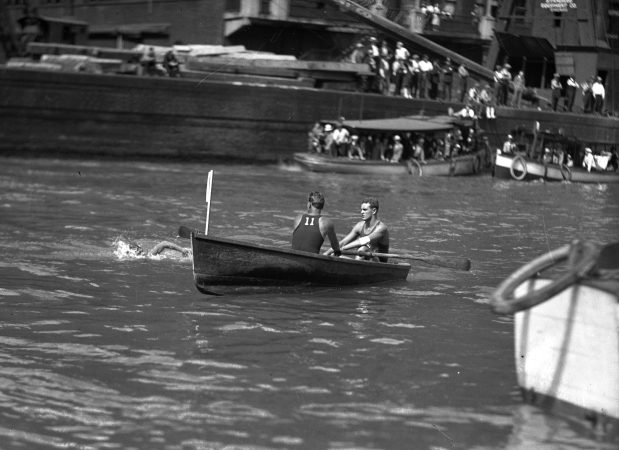On Sept. 22, some 500 participants are expected to jump in downtown waters for the Chicago River Swim, 116 years after a similar event prompted the Tribune headline: “Germs Of Chicago River Mere Bagatelle To Girl.”
“Regardless of the fact that the Chicago River is said to contain the most dangerous of germs, seventy-one swimmers of more or less fame in western aquatic circles will line up at one o’clock today on the life-saving pier at the entrance to the harbor for the first annual marathon swim of the Illinois Athletic club,” the accompanying story reported on July 18, 1908.
The scheduled competitors included “Miss Anna Harris, who learned to swim in the Milwaukee River.” Her gumption in choosing to compete against 69 men while also braving the questionable quality of the river water was apparently enough to merit a headline for a preview on the event.
Chicago was a latecomer to swimming marathons. Enthusiasts of such endeavors consider Lord George Gordon Byron, better known as Lord Byron their patron saint. In May 1810, the celebrated British poet swam the Hellespont, four miles of water separating Europe from Asia.
He found his muse in the Greek myth of two lovers: Leander who lived on the European side of the strait, and Hero, on the Asian side. In “Written after Swimming from Sestos to Abydos,” Lord Byron observed:
For me, degenerate modern wretch,
Though in the genial month of May,
My dripping limbs I faintly stretch,
And think I’ve done a feat today.
Competitive swimming of shorter lengths got a boost in 1896, when the ancient Olympics were revived in Athens and races were held in the nearby Bay of Zea.
The Chicago River was for much of the city’s history an unlikely sports venue. It was for many years considered an open-air sewer. Residents dumped garbage and human and animal waste into it, making the river a Petri dish for malaria germs. Flowing into Lake Michigan, the river contaminated the city’s drinking water.
A solution was obvious — send the water away from the lake — but not easily accomplished. In 1900, the Chicago River was connected to a canal that fed a complex of rivers flowing into the Mississippi River. Locks reversed the river, except on occasions when climatic events decided otherwise.
In March of 1908, a torrential rain overpowered the system. The river flowed back toward the lake, endangering the city’s water supply and the swimming races. But by carefully maneuvering the locks, engineers redirected the waters and enabled the race to go on.
Nonetheless, the Tribune sounded a skeptical note.
“The Chicago River, now said to be more or less deodorized, will have a chance to speak for itself shortly,” the paper wrote on June 26 in a preview of a race in which “forty of fifty young athletes will race each other in a ‘marathon’ swim from the Rush Street bridge to Twelfth Street.”
“That is, providing the chameleon colored waters do not produce the scent they once did.”
On a more optimistic note, it was noted that “Up at Goose Island boys have always taken a daily plunge in summer, and although there have been numerous records of drownings there have been none of suffocation or asphyxiation.”
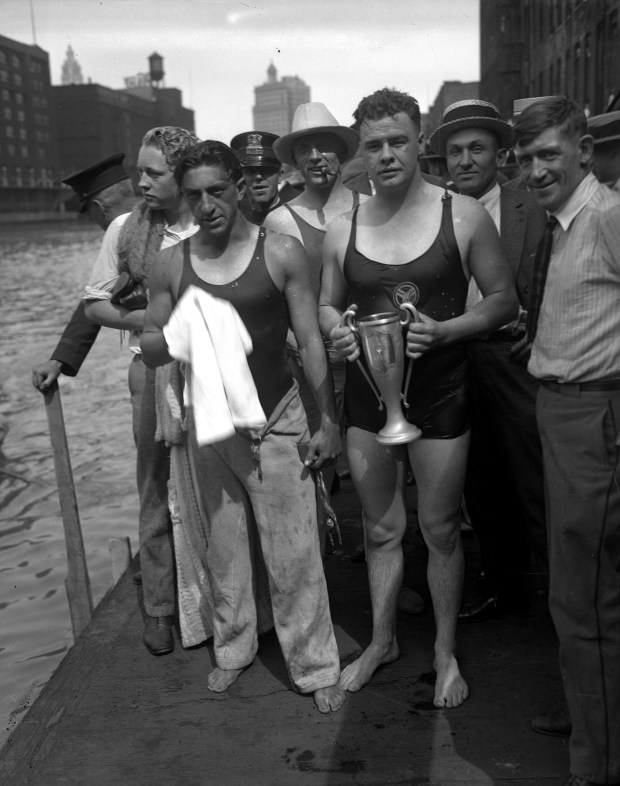
The previous year, the Illinois Athletic Club, a tony Michigan Avenue private club, sponsored a 10-mile swim in Lake Michigan. It did not go well. None of the 20 or so swimmers who “attempted to paddle their way from the Columbia Yacht Club to the South Shore Country Club” made it more than half way.
“Three of the men who went farthest were delirious when they were taken from the water,” according to the Tribune’s story.
In 1908, the race was not nearly as lengthy.
”Two miles is a short course,” said Charles Zeller, the race manager, “but we have made the swim short on account of the past notoriety which the river has had. I believe the water is clean enough for any one to swim in.“
Hoping to put that to rest, the race sponsors staged a photo shoot in July, a week before the race. The caption noted: “Sixteen sturdy swimmers took a sunset dip into the Chicago River at the life saving station just outside the harbor and, dodging between big steamers and tugs, landed at the Clark Street bridge.”
The swimmers gave a thumbs-up to the waters of the Chicago River, which in “former years have been asserted to contain the deadliest of germs.”
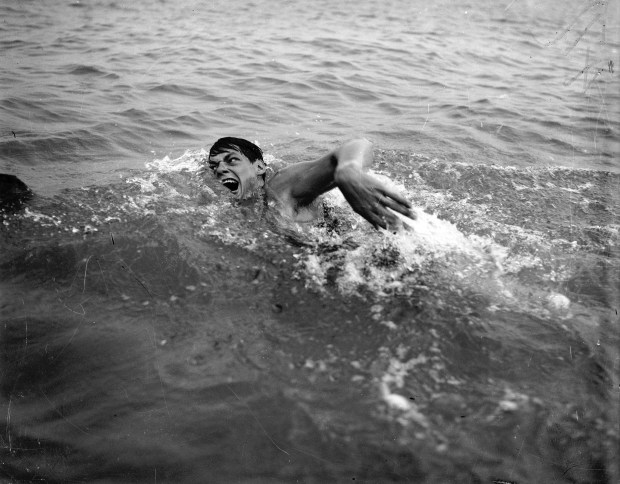
The July 1908 race began at the life-saving station at the harbor’s edge, passed into the river and ended near the Jackson Boulevard bridge. S.C. Jensen of the Illinois Athletic Club won, having overcome a teammate, H.J. Handy.
“When Handy reached Rush Street he was about 300 yards ahead of Jensen and gaining steadily, but the cool water and the terrific pace began to tell on him, and when a few minutes later he was seized with sever chills he was saved only by quick work on the part of Frank Sullivan, swimming director of the Illinois Athletic Club, who was rowing a few feet ahead of him,” the Tribune reported.
The oldest competitor wasn’t so fortunate. Albert G. Freese, 55, keeper of a saloon at Milwaukee Avenue and Huron Street was within striking range of the leaders when, having completed four-fifths of the two mile race, he sank. Spectators screamed in horror.
“Five men flung themselves into the river and swam to his aid, but he did not rise. The strong current whirled his body away, making diving and dragging useless,” the Tribune reported.
“Although the drowning was practically unavoidable it probably would finish the giving of marathon races by the Illinois Athletic Club,” director Zeller said.
But with measures taken to prevent another drowning, the race was held the following year. “Each competitor will be compelled to have a boat accompany him on the journey which will be manned by expert swimmers,” the Tribune reported.
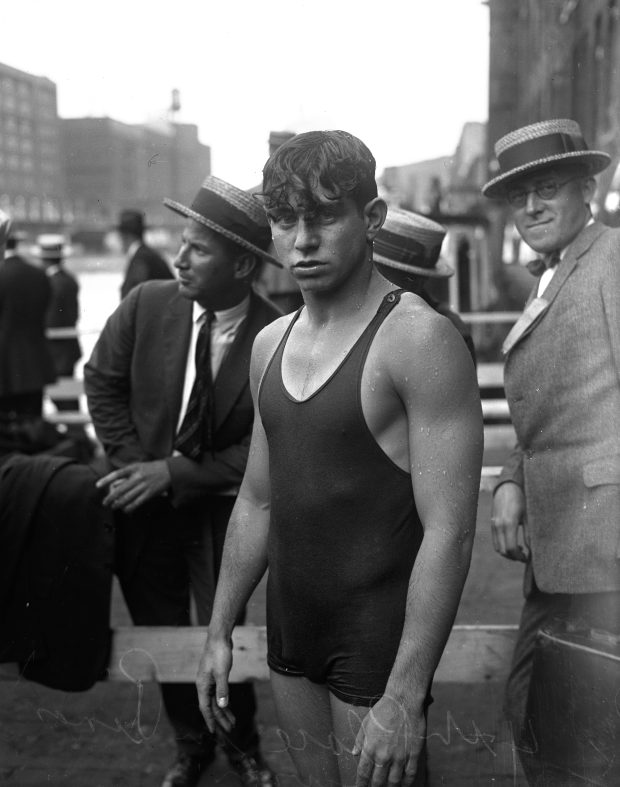
In the 1911 race, a temporarily missing swimmer prompted fears of another unfortunate mishap.
“One wild rumor was circulated as soon as the race was finished that Charles R. Carlson, an Englishman, had drowned during the progress of the race,” The Tribune observed.
“When seen at the dressing tent near the Columbia Yacht Club he said the report was ‘grossly exaggerated.’ He said that near the Adams Street bridge he felt a cramp in his legs and for several moments was unconscious. Friends in a rowboat, noting his condition, went to his rescue and pulled him out of the water.”
By then, the river races were firmly anchored by a silver trophy donated by Mayor William Thompson. “Big Bill” was known for handing out goodies so Chicagoans would overlook the hand with which he was looting the municipal till.
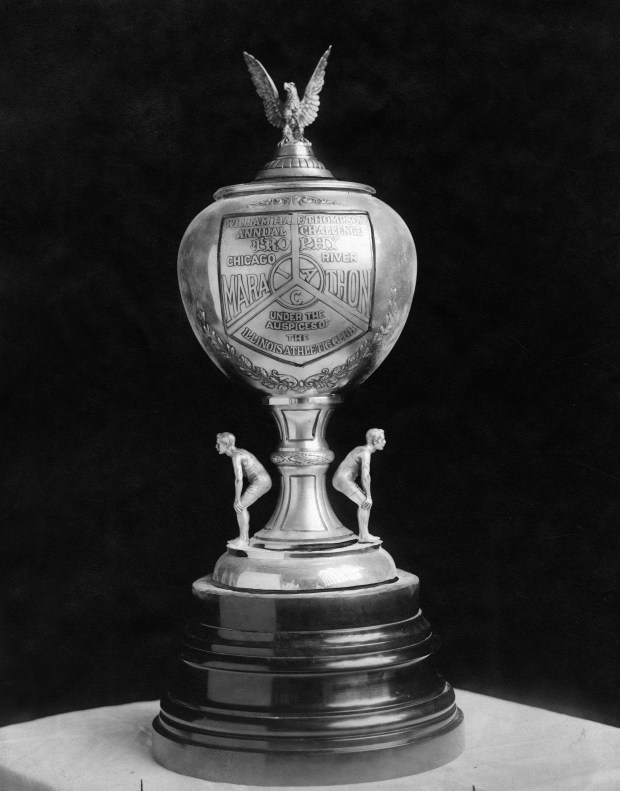
The river race was lengthened: Competitors went into the water at the Municipal Pier, as Navy Pier was then known. They swam through Lake Michigan, entered the river through the lock, and finished three miles from where they started.
Over the following years, some races were particularly noteworthy. The 1913 race was a tad zany.
It corresponded with a water carnival in honor of Commodore Oliver Hazard Perry, who won a critical battle in the War of 1812.
“It is the intention of the committee to have the swimmers in the water at the time revenue cutters escort Perry’s flagship, the Niagara, into the harbor,” the Tribune reported of sixth race. “The national salutes which the old wind jammer will receive is expected to stir the swimmers to greater efforts.”
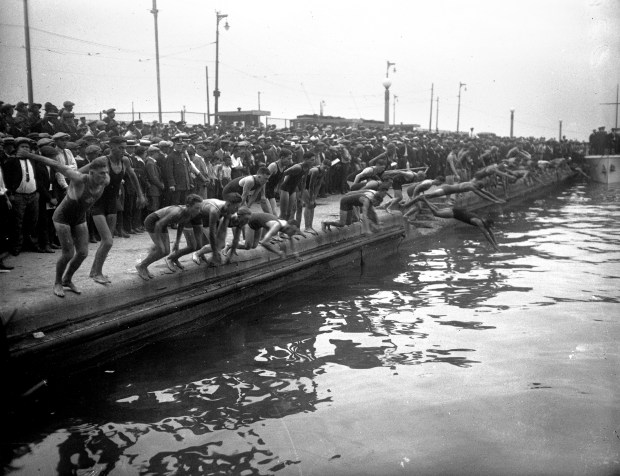
In 1927 the winner of the race was a future matinee idol: “By use of his powerful crawl stroke, Johnny Weissmuller of the Illinois A.C., generally consider the greatest all-around swimmer in the world, yesterday won the nineteenth annual river swim of the tri-color club.”
Weissmuller went on to fame as Hollywood’s Tarzan.
The Chicago River Swim’s history beyond the 1920s is murky. After being held annually until about 1930, the Tribune reported that the race was renewed, for at least one year, in 1937. Even with the city’s waste flowing the other way, the waterway came to be seen as unsafe, or at least unsavory for swimming for much of the latter part of the 20th century and beyond.
Promoters of the revived event can only hope Sept. 22 brings good weather and clean water, and then maybe the Tribune will be reporting on a scene like that described during the 1909 race:
“How many thousands of persons viewed the race may never be known. But from the mouth of the river to Jackson Street, a distance of two miles, the banks were packed with spectators, all shouting and cheering for the swimmers. The windows of all the buildings along the river were crowded and hundreds of persons witnessed the race from the roofs.”
Have an idea for Vintage Chicago Tribune? Share it with Ron Grossman and Marianne Mather at rgrossman@chicagotribune.com and mmather@chicagotribune.com.


